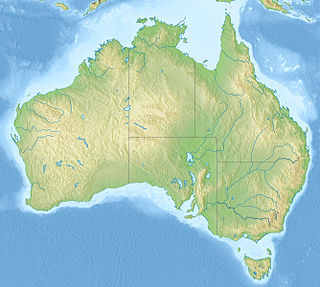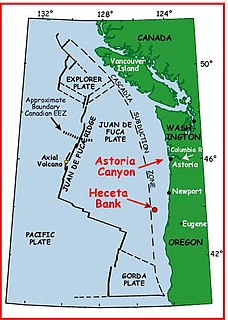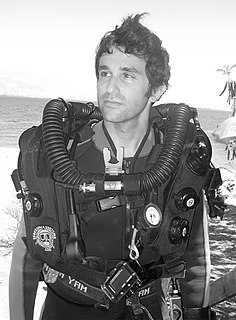Related Research Articles

The blue whale is a marine mammal belonging to the baleen whale suborder Mysticeti. Reaching a maximum confirmed length of 29.9 meters and weight of 173 tonnes, it is the largest animal known to have ever existed. The blue whale’s long and slender body can be various shades of grayish-blue dorsally and somewhat lighter underneath.

Salmonidae is a family of ray-finned fish, the only living family currently placed in the order Salmoniformes. It includes salmon, trout, chars, freshwater whitefishes, and graylings, which collectively are known as the salmonids. The Atlantic salmon and trout of the genus Salmo give the family and order their names.

Many types of fish migrate on a regular basis, on time scales ranging from daily to annually or longer, and over distances ranging from a few metres to thousands of kilometres. Fish usually migrate to feed or to reproduce, but in other cases the reasons are unclear.

Glyphis is a genus in the family Carcharhinidae, commonly known as the river sharks. This genus was thought to contain five different species, but recent studies on molecular data revealed that the species Glyphis gangeticus has an irregular distribution in the Indo-West Pacific region. This genus contains only four extant species. Further species could easily remain undiscovered, due to the secretive habits of Glyphis sharks. Their precise geographic range is uncertain, but the known species are documented in parts of South Asia, Southeast Asia, New Guinea, and Australia. Of the four currently described species, the Ganges shark is restricted to freshwater, while the northern river shark and the speartooth shark are found in coastal marine waters, as well. While the bull shark is sometimes called both the river shark and the Ganges shark, it should not be confused with the river sharks of the genus Glyphis. The River sharks of the genus Glyphis, remain very poorly known to science. They are facing a critically endangered status since river sharks are so poorly studied, and people know very little about their population and life history. One of the primary threats to River Sharks is habitat degradation which includes: human development, pollution, and fishing. The river shark is known to be one of the most rare sharks in the world. They have been found in nine different tidal areas, which consists of muddy waters with a low salinity. Their placement in connection to coastal marine waters indicate that they are usually born around October.

A cold seep is an area of the ocean floor where hydrogen sulfide, methane and other hydrocarbon-rich fluid seepage occurs, often in the form of a brine pool. Cold does not mean that the temperature of the seepage is lower than that of the surrounding sea water. On the contrary, its temperature is often slightly higher. The "cold" is relative to the very warm conditions of a hydrothermal vent. Cold seeps constitute a biome supporting several endemic species.

Oncorhynchus is a genus of fish in the family Salmonidae; it contains the Pacific salmon and Pacific trout. The name of the genus is derived from the Greek ὄγκος + ῥύγχος, in reference to the hooked jaws of males in the mating season.

Ocean Guardian is the manufacturer of devices that use Shark Shield Technology. The electrical wave-form used in the Shark Shield Technology is based on a technology originally invented by the KwaZulu-Natal Sharks Board of South Africa in the 1990s.

Kiwa hirsuta is a crustacean discovered in 2005 in the South Pacific Ocean. This decapod, which is approximately 15 cm (5.9 in) long, is notable for the quantity of silky blond setae covering its pereiopods. Its discoverers dubbed it the "yeti lobster" or "yeti crab".

Animal migration tracking is used in wildlife biology, conservation biology, ecology, and wildlife management to study animals' behavior in the wild. One of the first techniques was bird banding, placing passive ID tags on birds legs, to identify the bird in a future catch-and-release. Radio tracking involves attaching a small radio transmitter to the animal and following the signal with a RDF receiver. Sophisticated modern techniques use satellites to track tagged animals, and GPS tags which keep a log of the animal's location. One of the many goals of animal migration research has been to determine where the animals are going; however, researchers also want to know why they are going "there". Researchers not only look at the animals' migration but also what is between the migration endpoints to determine if a species is moving to new locations based on food density, a change in water temperature, or other stimulus, and the animal's ability to adapt to these changes. Migration tracking is a vital tool in efforts to control the impact of human civilization on populations of wild animals, and prevent or mitigate the ongoing extinction of endangered species.

The Global Ocean Sampling Expedition (GOS) is an ocean exploration genome project whose goal is to assess genetic diversity in marine microbial communities and to understand their role in nature's fundamental processes. It was begun as a Sargasso Sea pilot sampling project in August 2003; Craig Venter announced the full expedition on 4 March 2004. The two-year journey, which used Craig Venter's personal yacht, originated in Halifax, Canada, circumnavigated the globe and terminated in the U.S. in January 2006. The expedition sampled water from Halifax, Nova Scotia to the Eastern Tropical Pacific Ocean. During 2007, sampling continued along the west coast of North America.

The environmental impact of fishing includes issues such as the availability of fish, overfishing, fisheries, and fisheries management; as well as the impact of industrial fishing on other elements of the environment, such as by-catch. These issues are part of marine conservation, and are addressed in fisheries science programs. According to a 2019 FAO report, global production of fish, crustaceans, molluscs and other aquatic animals has continued to grow and reached 172.6 million tonnes in 2017, with an increase of 4.1 percent compared with 2016. There is a growing gap between the supply of fish and demand, due in part to world population growth.

Marine viruses are small infectious agents found in the ocean that require living host machinery for replication. They consist of a core of nucleic acids coated with protein, as they have the traditional virus assemblage. The dominant hosts for viruses in the ocean are marine microorganisms such as cyanobacteria. Viruses that that live as obligate parasitic agents in marine bacteria are known as marine bacteriophages or marine phages. The existence of viruses in the ocean was discovered through electron microscopy and epifluorescence microscopy of ecological water samples, and later through metagenomic sampling of uncultured viral samples. Marine viruses, although microscopic and essentially unnoticed by scientists until recently, are the most abundant and diverse biological entities in the ocean. Viruses have an estimated abundance of 1030 in the ocean, or between 1 and 100,000x106 per millilitre. Quantification of marine viruses was originally performed using transmission electron microscopy but has been replaced by epifluorescence or flow cytometry.
The Future of Marine Animal Populations (FMAP) project was one of the core projects of the international Census of Marine Life (2000–2010). FMAP's mission was to describe and synthesize globally changing patterns of species abundance, distribution, and diversity, and to model the effects of fishing, climate change and other key variables on those patterns. This work was done across ocean realms and with an emphasis on understanding past changes and predicting future scenarios.
Enric Sala is a former university professor who saw himself writing the obituary of ocean life, and quit academia to become a full-time conservationist as a National Geographic Explorer-in-Residence. Sala’s present goals are to help protect critical marine ecosystems worldwide, and to develop new business models for marine conservation. He also produces documentary films and other media to raise awareness about the importance of a healthy environment, and to inspire country leaders to protect more of the natural world.

The reef manta ray is a species of ray in the family Mobulidae, one of the largest rays in the world. Among generally recognized species, it is the second-largest species of ray, only surpassed by the giant oceanic manta ray.
In molecular biology mir-383 microRNA is a short RNA molecule. MicroRNAs function to regulate the expression levels of other genes by several mechanisms.
Mexican native trout —Mexican rainbow trout, sometimes Baja rainbow trout and Mexican golden trout occur in the Pacific ocean tributaries of the Baja California peninsula and in the Sierra Madre Occidental of northwest Mexico as far south as Victoria de Durango in the state of Durango. Many forms of the Mexican rainbow trout, subspecies of the rainbow trout, have been described. The Mexican golden trout is a recognized species.

The Bremer Marine Park is a 4472 km2 marine protected area, with a depth range of about 15–5000 m, lying in the Indian Ocean off the southern coast of Western Australia about 50 km south-east of the town of Bremer Bay. An area of 284 km2, comprising the northernmost section adjoining Western Australia's coastal waters, has been zoned as a marine national park, with the remainder as multiple use or special purpose zones.

Heceta Bank is a rocky bank located 55 kilometers (km) off the Oregon coast near Florence, centered on approximately 44°N, 125°W, and is roughly 29 km long and upwards of 13 km wide. Heceta Bank is an area of ecological and oceanographic importance. The unique bathymetric features and seasonal circulation within the bank provides habitat for a diversity of economically-important fish species.

David Gruber is an American marine biologist, a Presidential Professor of Biology and Environmental Sciences at Baruch College, City University of New York, and a National Geographic Explorer.
References
- ↑ "Program Description on CoML Website". Coml.org. Archived from the original on 2009-03-28. Retrieved 11 July 2018.
- ↑ "PLOS Collections: Article collections published by the Public Library of Science". Ploscollections.org. doi:10.1371/issue.pcol.v01.i05 . Retrieved 11 July 2018.
- ↑ "Archived copy". Archived from the original on 2014-02-27. Retrieved 2013-05-22.CS1 maint: archived copy as title (link)
- ↑ Moore, Megan E.; Goetz, Fred A.; Doornik, Donald M. Van; Tezak, Eugene P.; Quinn, Thomas P.; Reyes-Tomassini, Jose J.; Berejikian, Barry A. (20 September 2010). "Early Marine Migration Patterns of Wild Coastal Cutthroat Trout (Oncorhynchus clarki clarki), Steelhead Trout (Oncorhynchus mykiss), and Their Hybrids". PLOS ONE. 5 (9): e12881. doi:10.1371/journal.pone.0012881. PMC 2942839 . PMID 20862225 . Retrieved 11 July 2018– via PLoS Journals.
- ↑ Andrews, Kelly S.; Williams, Greg D.; Levin, Phillip S. (8 September 2010). "Seasonal and Ontogenetic Changes in Movement Patterns of Sixgill Sharks". PLOS ONE. 5 (9): e12549. doi:10.1371/journal.pone.0012549. PMC 2935885 . PMID 20838617 . Retrieved 11 July 2018– via PLoS Journals.
- ↑ Reynolds, Brad F.; Powers, Sean P.; Bishop, Mary Anne (13 August 2010). "Application of Acoustic Telemetry to Assess Residency and Movements of Rockfish and Lingcod at Created and Natural Habitats in Prince William Sound". PLOS ONE. 5 (8): e12130. doi:10.1371/journal.pone.0012130. PMC 2921330 . PMID 20730090 . Retrieved 11 July 2018– via PLoS Journals.